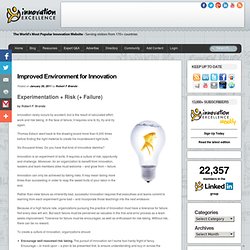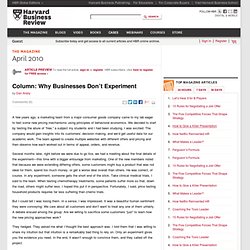

The Start-up Owner's Manual: Customer Development Experiments. Editor's note: This post is part of a series featuring excerpts from the recently published book, The Startup Owner's Manual, written by serial entrepreneurs-turned-educators Steve Blank and Bob Dorf.

Come back each week for more how-tos from this 608-page guide. Once your Business Model Canvas is done, it's time for your team to "get out of the building" to test your hypotheses. You need to answer three key questions: Do we really understand the customer's problem or need? Do enough people care about the problem or need to deliver a huge business? Regardless of whether you have a physical or Web/mobile product, Customer Development experiments are short, simple, objective pass/fail tests. Start by asking yourself, "What do I want to learn?
" Run a Disciplined Innovation Experiment - Video. Intellectual Flexibility. Improved Environment for Innovation. Experimentation + Risk (+ Failure) by Robert F.

Brands Innovation rarely occurs by accident, but is the result of calculated effort, work and risk taking. In the face of failure, it requires one to try, try and try again. Thomas Edison went back to the drawing board more than 6,000 times before finding the right material to create his incandescent light bulb. The Best Diagnostic Question and Amazon. The final point that Jeff Pfeffer and I make in Hard Facts is about failure.

We emphasize that is impossible to run an organization without making a lot of mistakes. Innovation always entails failure. Most new products and companies don’t survive. And if you want creativity without failure, you are living in a fool’s paradise. Are You Squandering Your Intelligent Failures? - Rita McGrath. Column: Why Businesses Don’t Experiment. A few years ago, a marketing team from a major consumer goods company came to my lab eager to test some new pricing mechanisms using principles of behavioral economics.

We decided to start by testing the allure of “free,” a subject my students and I had been studying. I was excited: The company would gain insights into its customers’ decision making, and we’d get useful data for our academic work. The team agreed to create multiple websites with different offers and pricing and then observe how each worked out in terms of appeal, orders, and revenue. Several months later, right before we were due to go live, we had a meeting about the final details of the experiment—this time with a bigger entourage from marketing. One of the new members noted that because we were extending differing offers, some customers might buy a product that was not ideal for them, spend too much money, or get a worse deal overall than others.
Experiments – the Key to Innovation. There is a big problem that organisations often face: they want to be innovative, but they also want to minimise risk.

This creates a certain amount of tension. If I had to pick the number one thing that I would recommend to organisations that are trying to become more innovative, it would be this: experiment. Fast-Cycle Capability for Competitive Power. To innovate, experiment. By Saul Kaplan, contributor FORTUNE -- Learn by doing.

Constantly test new ideas. Learn, share and repeat. The world is ever changing -- stay ahead of the curve. Embrace the art of discovery. We need to try more stuff. Geoffrey Canada, the inspiring founder of the Harlem Children's Zone in NYC, reminds us of the importance of constant experimentation. Business model innovation is all about experimentation. We also must get far more comfortable with hacking capabilities. A good example of the power and potential of hacking capabilities is Microsoft's (MSFT) Kinect. Microsoft predictably launched Kinect with it's deeply ingrained proprietary product mind set.
And hack they will. Microsoft's initial knee-jerk reaction was as expected, negative. Hacking capabilities can unleash new sources of value and solutions for many of the social system challenges we face today. This piece is adapted from The Business Model Innovation Factory. Where Do Bad Ideas Come From? There’s been a lot of buzz about Steven Johnson’s book Where Good Ideas Come From.

An article in Foreign Policy by Stephen Walt addresses the opposite question: Where Do Bad Ideas Come From? He is talking about bad ideas in foreign policy, such as the domino effect, which have been used to justify policy but which have failed to be supported by actual facts or events. In part, Walt thinks that bad ideas result from an inability to learn from error: All countries have obvious incentives to learn from past mistakes, but those that have successfully risen to the status of great powers may be less inclined to adapt quickly in the future.
When it comes to learning the right lessons, paradoxically, nothing fails like prior success.This wouldn’t seem to make sense. If you think about this, it sounds a whole lot like the Innovator’s Dilemma, doesn’t it? The basic premise is that success reduces the incentive to innovate, which results in the propagation of bad ideas. Here are the key points: